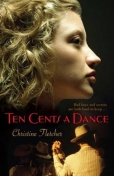BKMT READING GUIDES
Ten Cents a Dance
by Christine Fletcher
Hardcover : 368 pages
2 clubs reading this now
3 members have read this book
Introduction
In 1941, when her mother becomes too ill to work, fifteen-year-old Ruby Jacinski has to drop out of school and support her family. Working in one of Chicago’s meatpacking plants makes life feel like one long dead end…until she meets neighborhood bad boy, Paulie Suelze. Soon, Ruby discovers how to earn money—lots of money—while wearing silk and satin and doing what she does best: dancing. Paid to lead lonely men around a dance hall floor, Ruby quickly learns the art of “fishing”: working her patrons for meals, cash, clothes, even jewelry. As long as her family doesn’t find out what she’s doing, her problems—and theirs—are solved. But as Ruby is drawn deeper into Chicago’s underworld, swinging with the hepcats becomes swimming with the sharks…and she discovers that secrets and bad boys are both hard to keep. A mesmerizing look into a little known world and era, Ruby’s story is resplendent with soul-shaking jazz, killer `40s style, and the passions of a young generation on the eve of war.
Excerpt
Chapter 1We heard the music even before we got to Union Hall. Turned the corner and there it was, big double doors flung open, yellow light bright as butter spilling into the cold October air. Kids swarmed the front steps of the hall, the boys in ties and their good shoes, the girls’ skirts shimmying below wool coats. More were coming. Hustling up the sidewalks from all directions. I didn’t recognize a single person. ...
Discussion Questions
1. Ruby is attracted to Paulie in part because of his tough guy reputation. At what point does she realize what Paulie is truly capable of? Should she have realized it earlier? Why do you think tough guys can be so appealing?2. Peggy asserts to Ruby that “every taxi dancer has a story.” What does she mean by this? What do you think it says about the girls who became taxi dancers?
3. Yvonne is in her mid-twenties, older than most of the other dancers, and at the beginning of the book she’s the best earner at the Starlight. Why is she so hostile to Ruby? What do you think the future holds for Yvonne?
4. When Ruby is “fishing” Tom, Peggy accuses her of trying to “have it both ways.” What does Peggy mean? How does Peggy manage to “fish” successfully, without creating the same consequences that Ruby faces?
5. On Ruby’s first foray to a black-and-tan club, she thinks, “I’d certainly never seen Negro and white sitting together. Dancing together. Holding hands.” As Ruby begins to frequent the black-and-tans, how does this influence her opinion of the jazz trumpeter, Ozzie? What impact do her experiences have on her views about ethnicity and race? Do her views shift for noble reasons, or practical ones?
6. Ruby and her mother struggle with each other throughout the book: Ruby for autonomy, her mother for authority. How does money influence this struggle?
7. Why do you think Ruby’s mother marries Chester? Love? Security? Or does she have another motive?
8. In the end, do you think Ruby made the right decision regarding Paulie? Do you think his comeuppance is too harsh, or not harsh enough? If you were in her shoes, would you make the same decision?
9. Do you think Ruby and Ozzie are attracted to each other? If so, why did neither act on it? Do you think they should have?
10. A central theme of Ten Cents a Dance is illusion. “In the taxi-dance business,” Del says, “if you ain’t got illusion, you ain’t got nothing.” What is he referring to? How does illusion play into Ruby’s relationship with Paulie? With her mother? With her sister, Betty? Does illusion color her view of the Starlight at the beginning of the book? What about by the end?
Notes From the Author to the Bookclub
TEN CENTS A DANCE was inspired by a story from my own family: my mother’s aunt who, after being kicked out of the house at the age of fifteen, supported herself as a taxi dancer. I’ve always loved the oddments of history—homely, everyday stuff which never makes it into the history books. Taxi dancing is like that. Taxi dance halls hired girls to dance with male customers (the girls were rented, like taxis, which was how they got their name). The pay was good, but in the morals of the time, taxi dancers were considered depraved characters, one step above prostitutes. Not surprisingly, many girls kept what they did a secret from their own families. The idea of leading a secret, double life fascinated me. As I imagined the kind of girl who could pull it off—and why she might have to—Ruby Jacinski was born. After that, I couldn’t rest until I knew her entire story. Immersing myself in Ruby’s world—hot jazz and beaded gowns, slaughterhouses and theater palaces, the Chicago lakeshore in summer, and a girl’s dare-anything love for a bad boy—made that time come alive for me. I hope it does for you, too.Book Club Recommendations
Recommended to book clubs by 1 of 1 members.
Book Club HQ to over 88,000+ book clubs and ready to welcome yours.
Get free weekly updates on top club picks, book giveaways, author events and more








